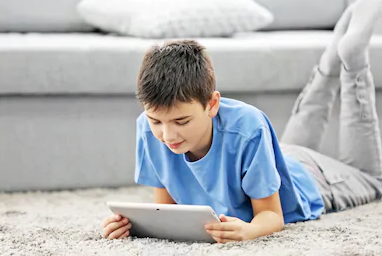Is the technology revolution good or bad for our kids and reading?

In this rapidly changing technological world, what has happened to children’s reading? Let’s take a look at amount of time that our children and teens are reading, their reading/academic achievements and how ereading (electronic reading) is changing the book landscape.
How frequently and for how long do our children and teens read?
Reading for fun reduces dramatically as children grow older and percentages among all children – especially our teenagers – have fallen markedly in recent years. A recent Scholastic study documents a drop from 48% of 6- to -8 year olds down to 24% of 15- to 17-years olds who are daily readers. Another study by NCES (National Centre for Education Statistics) indicated a sharp drop from 53% of 9 year olds to 19% of 17 year olds who read for fun.
Why are our teenagers reading less frequently? Is it because there isn’t enough captivating books? An increase in time spent on social media? Extra demands from school? Some would raise the question that the type of reading is hard to measure – do you measure time spent reading text messages and social media posts? Regardless, as parents and educators we can’t deny that reading results for young people have generally been improving while among adolescents these scores have declined.
Reading/Academic Achievement
Academic engagement is largely related to the concept of motivation. Motivation can be defined as “the spontaneous learning behaviours of children – whether they spring from an internalised sense of the intrinsic value of learning or from the rewards associated with it”.(Usher and Kober, 2012) Engagement can be seen as the outcome of a child’s motivation to learn. Put simply, motivated kids are engaged in their learning, and children who are engaged in their learning have a tendency to have higher levels of achievement.
Student engagement was at the core of developing Literacy for Boys – boys will read if the topic (or content) interests them. I was frustrated at the lack of boy-centric materials to use with reading so I started writing my own – they were an immediate hit (sport, science, scary stories, adventure, secret agents, motorbikes – choice and variety aimed at their interests is what re-engages kids with reading). Being an online program, this leads us to e reading.
Electronic Book Reading (ereading)
During the last 15 years there has been the evolution, then explosion, of electronic reading. Ebooks can be broadly classified into two categories: “basic” ebooks (those print books that have been uploaded into a digital format) and “enhanced” books (those which include interactive options such as games, videos, animation). So, can ereading affect children’s enjoyment, comprehension and retention? Some parents feel that their children already have enough ‘screen’ time and they don’t want ereading to affect the enjoyment of paper books. On the other hand, many ebooks contain audio (which can help children to pronounce difficult words), electronic dictionaries, the option to highlight sections plus appealing, interactive images/videos. The website Oxford Owl has a variety of books, both fiction and non-fiction, for children aged 4 – 11 years. Costs nothing to join.
Are boys more engaged with on-screen print rather than print books? Electronics can be a huge pull for older boys but it is still important to show them the value of printed books.
Summing up
How can we eliminate the stubborn and continuing gaps in reading frequency and achievement? There are still far too many children who read below a basic reading level and a disproportionate number of them are boys. Race, income and parent education may affect the above, but the issue still remains that too many kids are being left behind. While technology has made changes to the nature of reading, we can look at its benefits – how can we utilise it to promote reading skills and reignite kids’ passion for reading?
Check out our blogs for more ideas and tips.
Boys Love LFB – Here’s what they have to say!
Get boys reading in the digital age
Why write? Tips for reluctant writers
Brought to you by Tanya Grambower
